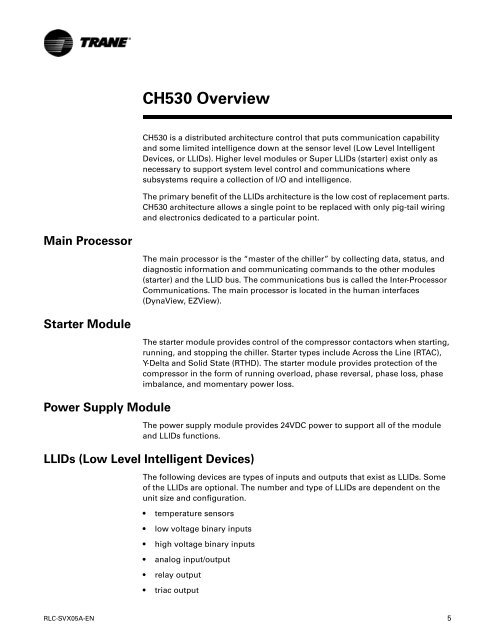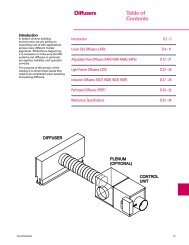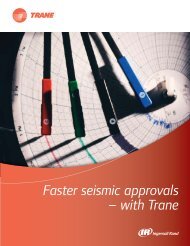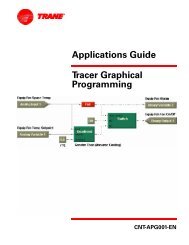RTHD and RTAC - Trane
RTHD and RTAC - Trane
RTHD and RTAC - Trane
You also want an ePaper? Increase the reach of your titles
YUMPU automatically turns print PDFs into web optimized ePapers that Google loves.
Main Processor<br />
Starter Module<br />
Power Supply Module<br />
CH530 Overview<br />
CH530 is a distributed architecture control that puts communication capability<br />
<strong>and</strong> some limited intelligence down at the sensor level (Low Level Intelligent<br />
Devices, or LLIDs). Higher level modules or Super LLIDs (starter) exist only as<br />
necessary to support system level control <strong>and</strong> communications where<br />
subsystems require a collection of I/O <strong>and</strong> intelligence.<br />
The primary benefit of the LLIDs architecture is the low cost of replacement parts.<br />
CH530 architecture allows a single point to be replaced with only pig-tail wiring<br />
<strong>and</strong> electronics dedicated to a particular point.<br />
The main processor is the “master of the chiller” by collecting data, status, <strong>and</strong><br />
diagnostic information <strong>and</strong> communicating comm<strong>and</strong>s to the other modules<br />
(starter) <strong>and</strong> the LLID bus. The communications bus is called the Inter-Processor<br />
Communications. The main processor is located in the human interfaces<br />
(DynaView, EZView).<br />
The starter module provides control of the compressor contactors when starting,<br />
running, <strong>and</strong> stopping the chiller. Starter types include Across the Line (<strong>RTAC</strong>),<br />
Y-Delta <strong>and</strong> Solid State (<strong>RTHD</strong>). The starter module provides protection of the<br />
compressor in the form of running overload, phase reversal, phase loss, phase<br />
imbalance, <strong>and</strong> momentary power loss.<br />
The power supply module provides 24VDC power to support all of the module<br />
<strong>and</strong> LLIDs functions.<br />
LLIDs (Low Level Intelligent Devices)<br />
The following devices are types of inputs <strong>and</strong> outputs that exist as LLIDs. Some<br />
of the LLIDs are optional. The number <strong>and</strong> type of LLIDs are dependent on the<br />
unit size <strong>and</strong> configuration.<br />
temperature sensors<br />
low voltage binary inputs<br />
high voltage binary inputs<br />
analog input/output<br />
relay output<br />
triac output<br />
RLC-SVX05A-EN 5
















